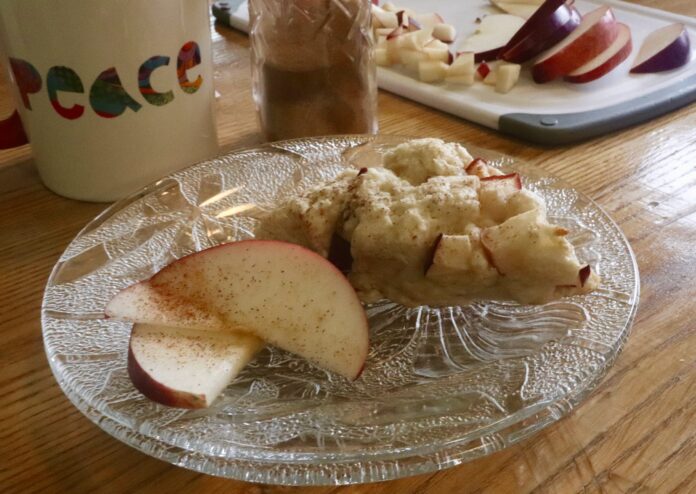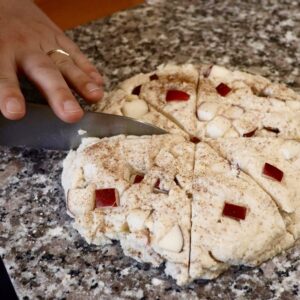
I spent the limbo period between high school and college working at a small café in Mt. Vernon, Maine. What I remember of that summer blurs together all the months and weeks into one singular day of exhaustion and meditation. The specifics that I do remember come back most vividly when I smell these scones baking in my oven at home.
At least four days a week that summer, I woke myself up in the dark at 3:50 a.m. and battled my body’s every impulse to fall back asleep. I listened to the BBC on my clock radio — it was almost 9 a.m. in London. My eyes twitched and burned when I finally convinced myself to turn on the light in my room and dress myself.
Somehow, I was always able to keep my eyes open on my 30-minute commute to work. The roads were eerily beautiful in the early hours. The thick morning fog always settled into the dips in the road and created halos around my headlights and the street lamps in the darkness. My eyes flitted from the road to the houses I passed, searching for an unlikely lit window.
When I would arrive and walk up to the café, I could often hear loons on the lake and the smallest glint of sunlight gave the sky a spectacular deep blue. When I jiggled my key to release the tired old latch of the shop’s front door, I was always nervous it would get stuck. When I entered the dark shop, relieved, I would pace through the rooms — flicking all the switches on the lights, the oven, the coffee maker.
I would have the next two and a half hours in the shop to myself, so I partially did as I pleased. I would start by baking scones, and I made a different iteration every day. It’s a simple recipe that lends well to an early morning brain and accidental memorization. I was thankful for this, since my strange sleep schedule left me feeling only half-awake most days. I dropped things, forgot things and I remember one morning I was so tired, I absent-mindedly reached for a hot sheet-pan palm forward, burning the skin between my thumb and pointer finger.
The scones didn’t complain of my mental absence, they adapted with me. Purposefully or by accident, I adjusted the amount of sugar, oven temperature and wetness of the dough in my search for the perfect recipe. Day after day, I could taste the difference. Luckily, the results were always edible, always sellable and always quite good. While I entered into the job with minimal baking knowledge, those early hours baking alone gave me the confidence to experiment.
I never had to set a timer for the scones. I always seemed to check them in time, like in some strange way they became an extension of myself after so many mornings together. The sun rose as I quietly watched the houses across the street turn on their own lights and as the fog sank away from the lake.
I liked the kitchen best this way, alone listening to public radio, the sizzle of a hot pan, feeling the heat of the oven. I think that for me, growing up was always about learning how to think for myself and swim against the tide of other peoples’ expectations of me. Spending time alone doing any sort of creative task is really good at relieving self-consciousness and self-editing. Something about how dark those early mornings were, and how they made me feel like I was the only person awake, felt liberating. It was like I could do anything.
If you make these scones yourself, you can add whatever fruit or other toppings you like, but some of my favorite combinations are sharp cheddar, spinach, chives and sun-dried tomato; cinnamon apple; lemon and rosemary. You can also add chocolate chips, cocoa powder or a glaze, though my more difficult customers always complained that a proper scone does not contain any of those delicious things. Feel free to disregard their prudish comments, and embrace your own baking inhibitions, as I learned to.

Scone Recipe (makes 8)
Preheat the oven to 315 degrees Farenheight
Dry Ingredients:
2 cups flour
1/4–1/3 cup sugar, depending on how sweet you want the scones to be
1 tablespoon baking powder
1/4 teaspoon salt
4 tablespoons butter
Using a food processor, pulse until the ingredients are combined into a coarse mixture and dump into a bowl. Or, if you don’t have a food processor, chop the butter into small half-inch pieces and stir to combine.
Wet ingredients:
1 1/3 cup heavy cream (separated)
Add 1 cup heavy cream to the bowl and stir to combine. Add any fillings — like fresh or dried fruit, chocolate, cheese — before forming the mixture into a ball and dumping it out onto a flat surface.
If you can, it’s nice to combine all the ingredients on a cold stone countertop, to keep the butter cold. If the butter melts before it goes into the oven, the scones will be hard and dense.
Add up to 1/4 cup more heavy cream if your ingredients are not forming a dough. All the dry ingredients should be integrated into the mixture, and it should feel slightly sticky but not too wet.
Start to knead the dough with your hands. Be careful not to overwork the ingredients, which would cause a gluten network to form, giving the scones a tight, stiff texture. I always combine the ingredients quickly with my fingers, and then quickly knead the dough by forming it into an oval, and squishing the dough on the countertop to reform the oval in the other direction.
Form the dough into a circle and cut into 8 triangles.
Take a small amount of heavy cream and drizzle it over the top of your scones. I always enjoy making a spiral, but you can make zig zags or even use a pastry brush.
Place the scones on a lined baking sheet.
Bake for 15 minutes or until slightly golden.
![]()


































